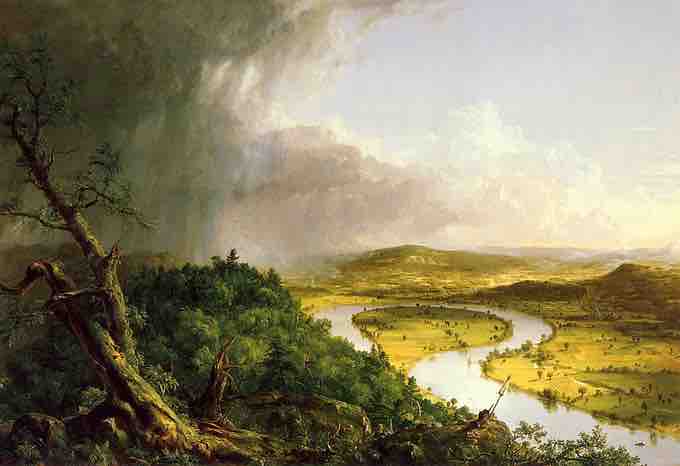Dutch and English Landscape Painting
Landscape painting depicts natural scenery such as mountains, valleys, trees, rivers, and forests, in which the main subject is typically a wide view and the elements are arranged into a coherent composition. During the Dutch Golden Age of painting of the 17th century, this type of painting greatly increased in popularity, and many artists specialized in the genre. In particular, painters of this era were known for developing extremely subtle, realist techniques of depicting light and weather. The popularity of landscape painting in this region, during this time, was in part a reflection of the virtual disappearance of religious art in the Netherlands, which was then a Calvinist society. In the 18th and 19th centuries, religious painting declined across all of Europe, and the movement of Romanticism spread, both of which provided important historical ingredients for landscape painting to ascend to a more prominent place in art.
In England, landscapes had initially only been painted as the backgrounds for portraits, and typically portrayed the parks or estates of a landowner. This changed as a result of Anthony van Dyck, who, along with other Flemish artists living in England, began a national tradition. In the 18th century, watercolor painting, mostly of landscapes, became an English speciality. The nation had both a buoyant market for professional works of this variety, and a large number of amateur painters. By the beginning of the 19th century, the most highly-regarded English artists were all, for the most part, dedicated landscapists, including John Constable, J.M.W. Turner, and Samuel Palmer .

The Hay Wain, by John Constable, 1821
Constable was a popular English Romantic Painter.
French Landscape Painting
French painters were slower to develop an interest in landscapes, but in 1824, the Salon de Paris exhibited the works of John Constable, an extremely talented English landscape painter. His rural scenes influenced some of the younger French artists of the time, moving them to abandon formalism and to draw inspiration directly from nature. During the revolutions of 1848, artists gathered in Barbizon to follow Constable's ideas, making nature the subject of their paintings. They formed what is referred to as the Barbizon School.
During the late 1860s, the Barbizon painters attracted the attention of a younger generation of French artists studying in Paris. Claude Monet, Pierre-Auguste Renoir, Alfred Sisley and Frédéric Bazille among others, practiced plein air painting and developed what would later be called Impressionism, an extremely influential movement.
In Europe, as John Ruskin noted, and Sir Kenneth Clark confirmed, landscape painting was the "chief artistic creation of the nineteenth century," and "the dominant art. " As a result, in the times that followed, it became common for people to "assume that the appreciation of natural beauty and the painting of landscape was a normal and enduring part of our spiritual activity. "
Nationalism in Landscape Painting
Nationalism has been implicated in the popularity of 17th century Dutch landscapes, and in the 19th century, when other nations, such as England and France, attempted to develop distinctive national schools of their own. Painters involved in these movements often attempted to express the unique nature of the landscape of their homeland.
The Hudson River School
In the United States, a similar movement, called the Hudson River School, emerged in the 19th century and quickly became one of the most distinctive worldwide purveyors of landscape pieces. American painters in this movement created works of mammoth scale in an attempt to capture the epic size and scope of the landscapes that inspired them. The work of Thomas Cole, the school's generally acknowledged founder, seemed to emanate from a similar philosophical position as that of European landscape artists. Both championed, from a position of secular faith, the spiritual benefits that could be gained from contemplating nature. Some of the later Hudson River School artists, such as Albert Bierstadt, created less comforting works that placed a greater emphasis (with a great deal of Romantic exaggeration) on the raw, terrifying power of nature.

The Oxbow, by Thomas Cole, 1836
Thomas Cole was a founding member of the pioneering Hudson School, the most influential landscape art movement in 19th Century America.